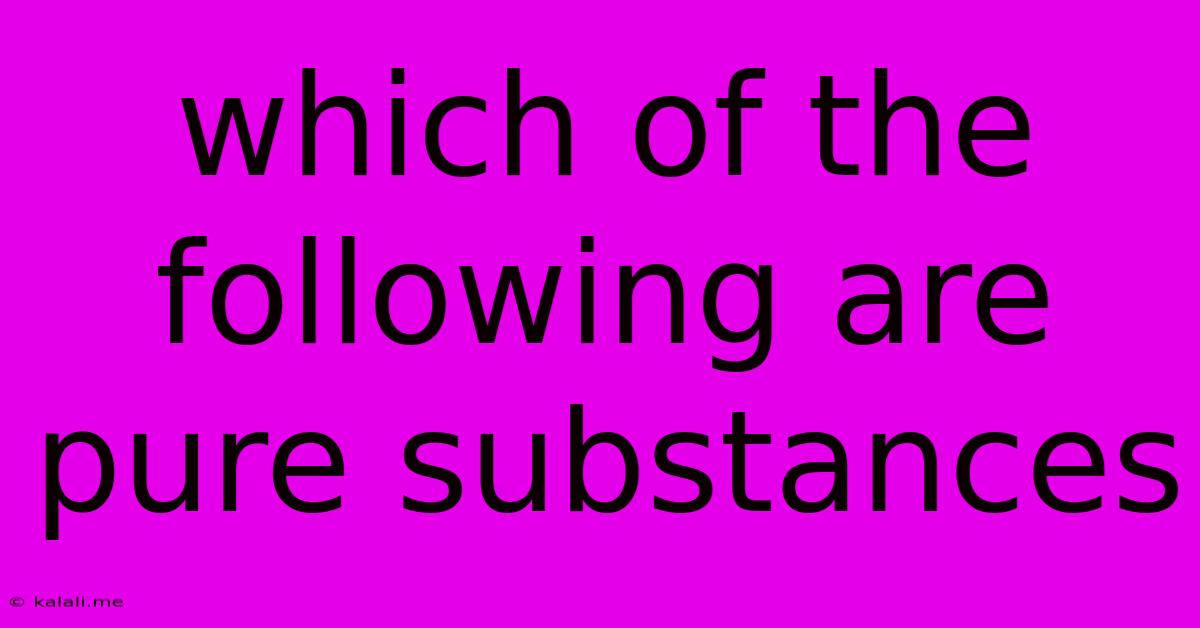Which Of The Following Are Pure Substances
Kalali
Jun 14, 2025 · 3 min read

Table of Contents
Which of the Following Are Pure Substances? A Comprehensive Guide
Meta Description: Learn to identify pure substances! This guide explains what constitutes a pure substance, differentiates it from mixtures, and provides clear examples to help you master this chemistry concept.
Understanding the difference between pure substances and mixtures is fundamental in chemistry. This article will delve into the definition of a pure substance, explore its characteristics, and provide examples to help you confidently distinguish it from mixtures. We'll also address common misconceptions.
What is a Pure Substance?
A pure substance is a form of matter that has a constant composition (meaning it's made up of only one type of atom or molecule) and has consistent properties throughout the sample. This means that no matter where you take a sample from, its chemical makeup will remain the same. It cannot be separated into different substances by physical methods. Think of it as a single, uniform entity.
Key Characteristics of Pure Substances
- Uniform Composition: The substance has the same chemical makeup throughout.
- Consistent Properties: Properties like melting point, boiling point, and density remain constant.
- Fixed Chemical Formula: A pure substance can be represented by a chemical formula (e.g., H₂O for water, NaCl for table salt).
- Cannot be Separated Physically: Physical methods like filtration, distillation, or evaporation cannot separate a pure substance into different components.
Types of Pure Substances
Pure substances are further categorized into two types:
-
Elements: Elements are pure substances that consist of only one type of atom. They cannot be broken down into simpler substances by chemical means. Examples include oxygen (O), hydrogen (H), gold (Au), and iron (Fe). The periodic table lists all known elements.
-
Compounds: Compounds are pure substances composed of two or more different elements chemically bonded together in a fixed ratio. They can only be separated into their constituent elements through chemical reactions. Examples include water (H₂O), table salt (NaCl), and carbon dioxide (CO₂).
Distinguishing Pure Substances from Mixtures
A mixture is a combination of two or more substances that are not chemically bonded. The components of a mixture retain their individual properties and can be separated by physical means. Mixtures can be homogeneous (uniform throughout, like saltwater) or heterogeneous (non-uniform, like sand and water).
Here's a simple way to think about it: If you can physically separate the components, it's a mixture. If you can't, it's likely a pure substance.
Examples: Identifying Pure Substances
Let's consider some examples to solidify your understanding. Imagine you have the following:
- Water (H₂O): This is a pure substance – a compound.
- Air: This is a mixture of gases, primarily nitrogen and oxygen.
- Sugar (Sucrose, C₁₂H₂₂O₁₁): This is a pure substance – a compound.
- Seawater: This is a mixture of water and various salts and minerals.
- Gold (Au): This is a pure substance – an element.
- Milk: This is a heterogeneous mixture containing water, fat, proteins, and carbohydrates.
Common Misconceptions
- Distilled water is not always a pure substance: While ideally distilled water should be pure H₂O, trace contaminants might be present depending on the distillation process.
- Pure substances can exist in different states: A pure substance, like water, can exist as ice (solid), liquid water, or steam (gas). The state change doesn't alter its chemical composition.
By understanding the defining characteristics and examples, you can confidently identify whether a substance is a pure substance or a mixture. Remember to focus on the uniformity of composition and the possibility of physical separation to make accurate classifications.
Latest Posts
Latest Posts
-
At What Stage In Life Does Abstract Thinking Begin
Jun 15, 2025
-
Part Of Brain That Controls Heartbeat
Jun 15, 2025
-
Biggest Cell In The Human Body
Jun 15, 2025
-
The Levels Of Processing Model Of Memory
Jun 15, 2025
-
What Is The Relation Between Frequency And Amplitude
Jun 15, 2025
Related Post
Thank you for visiting our website which covers about Which Of The Following Are Pure Substances . We hope the information provided has been useful to you. Feel free to contact us if you have any questions or need further assistance. See you next time and don't miss to bookmark.